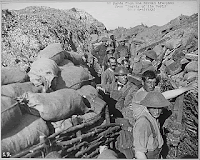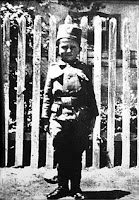1. Tanks had genders
 At the beginning of the war, tanks were grouped according to their
‘gender’. The male tanks had cannons attached while the females carried
machine guns. The prototype tank was named Little Willie.
At the beginning of the war, tanks were grouped according to their
‘gender’. The male tanks had cannons attached while the females carried
machine guns. The prototype tank was named Little Willie.
2. Explosions in France were heard in London
 A team of miners worked in secret to dig tunnels under the trenches
during the war in order to plant and detonate mines there. The
detonations destroyed much of the German front line and were so great,
the prime minister then heard the sound in London, 140 miles away.
A team of miners worked in secret to dig tunnels under the trenches
during the war in order to plant and detonate mines there. The
detonations destroyed much of the German front line and were so great,
the prime minister then heard the sound in London, 140 miles away.
3. Franz Ferdinand’s licence plate was the cause of a strange coincidence
 Archduke Franz Ferdinand and his wife were assassinated on June 28th
1914, an event which led to the beginning of the war. Strangely, the
Archduke’s number plate read: A 111 118, a series that can be read as,
Armistice 11 November ‘18.
Archduke Franz Ferdinand and his wife were assassinated on June 28th
1914, an event which led to the beginning of the war. Strangely, the
Archduke’s number plate read: A 111 118, a series that can be read as,
Armistice 11 November ‘18.
4. WWI saw pioneering advances in modern medicine
 Inspired by the sight of soldiers’ faces ravaged by shrapnel, many of
which remained covered by masks, Harold Gillies established the field
of plastic surgery, pioneering the first attempts of facial
reconstruction. As well as this, blood transfusions became routine to
save soldiers, with the first blood bank established on the front line
in 1917.
Inspired by the sight of soldiers’ faces ravaged by shrapnel, many of
which remained covered by masks, Harold Gillies established the field
of plastic surgery, pioneering the first attempts of facial
reconstruction. As well as this, blood transfusions became routine to
save soldiers, with the first blood bank established on the front line
in 1917.
5. The youngest authenticated combatant to serve was only 12 Many young men faked their age in order to sign up early. The
youngest to do so was Sidney Lewis, who was only 12 years old at the
time.
Many young men faked their age in order to sign up early. The
youngest to do so was Sidney Lewis, who was only 12 years old at the
time.
6. 12 million letters were delivered to the front every week
 Astonishingly, it only took two days for a letter from Britain
to reach the front in France. The journey began at a purpose-built
sorting depot in Regent's Park before being shipped to the trenches. By
the end of the war, two billion letters and 114 million parcels had had
been delivered.
Astonishingly, it only took two days for a letter from Britain
to reach the front in France. The journey began at a purpose-built
sorting depot in Regent's Park before being shipped to the trenches. By
the end of the war, two billion letters and 114 million parcels had had
been delivered.
Was the youngest soldier in the First World War In the beginning of August 1914, Austro-Hungarian soldiers killed his father, mother, grandmother, his three sisters, and four of his brothers. His house was also set on fire. Momčilo survived because he was not at home when it happened—his father had sent him to his uncle earlier.
 At the beginning of the war, tanks were grouped according to their
‘gender’. The male tanks had cannons attached while the females carried
machine guns. The prototype tank was named Little Willie.
At the beginning of the war, tanks were grouped according to their
‘gender’. The male tanks had cannons attached while the females carried
machine guns. The prototype tank was named Little Willie.2. Explosions in France were heard in London
 A team of miners worked in secret to dig tunnels under the trenches
during the war in order to plant and detonate mines there. The
detonations destroyed much of the German front line and were so great,
the prime minister then heard the sound in London, 140 miles away.
A team of miners worked in secret to dig tunnels under the trenches
during the war in order to plant and detonate mines there. The
detonations destroyed much of the German front line and were so great,
the prime minister then heard the sound in London, 140 miles away.3. Franz Ferdinand’s licence plate was the cause of a strange coincidence
 Archduke Franz Ferdinand and his wife were assassinated on June 28th
1914, an event which led to the beginning of the war. Strangely, the
Archduke’s number plate read: A 111 118, a series that can be read as,
Armistice 11 November ‘18.
Archduke Franz Ferdinand and his wife were assassinated on June 28th
1914, an event which led to the beginning of the war. Strangely, the
Archduke’s number plate read: A 111 118, a series that can be read as,
Armistice 11 November ‘18.4. WWI saw pioneering advances in modern medicine
 Inspired by the sight of soldiers’ faces ravaged by shrapnel, many of
which remained covered by masks, Harold Gillies established the field
of plastic surgery, pioneering the first attempts of facial
reconstruction. As well as this, blood transfusions became routine to
save soldiers, with the first blood bank established on the front line
in 1917.
Inspired by the sight of soldiers’ faces ravaged by shrapnel, many of
which remained covered by masks, Harold Gillies established the field
of plastic surgery, pioneering the first attempts of facial
reconstruction. As well as this, blood transfusions became routine to
save soldiers, with the first blood bank established on the front line
in 1917.5. The youngest authenticated combatant to serve was only 12
 Many young men faked their age in order to sign up early. The
youngest to do so was Sidney Lewis, who was only 12 years old at the
time.
Many young men faked their age in order to sign up early. The
youngest to do so was Sidney Lewis, who was only 12 years old at the
time.6. 12 million letters were delivered to the front every week
 Astonishingly, it only took two days for a letter from Britain
to reach the front in France. The journey began at a purpose-built
sorting depot in Regent's Park before being shipped to the trenches. By
the end of the war, two billion letters and 114 million parcels had had
been delivered.
Astonishingly, it only took two days for a letter from Britain
to reach the front in France. The journey began at a purpose-built
sorting depot in Regent's Park before being shipped to the trenches. By
the end of the war, two billion letters and 114 million parcels had had
been delivered.



Comments
Post a Comment